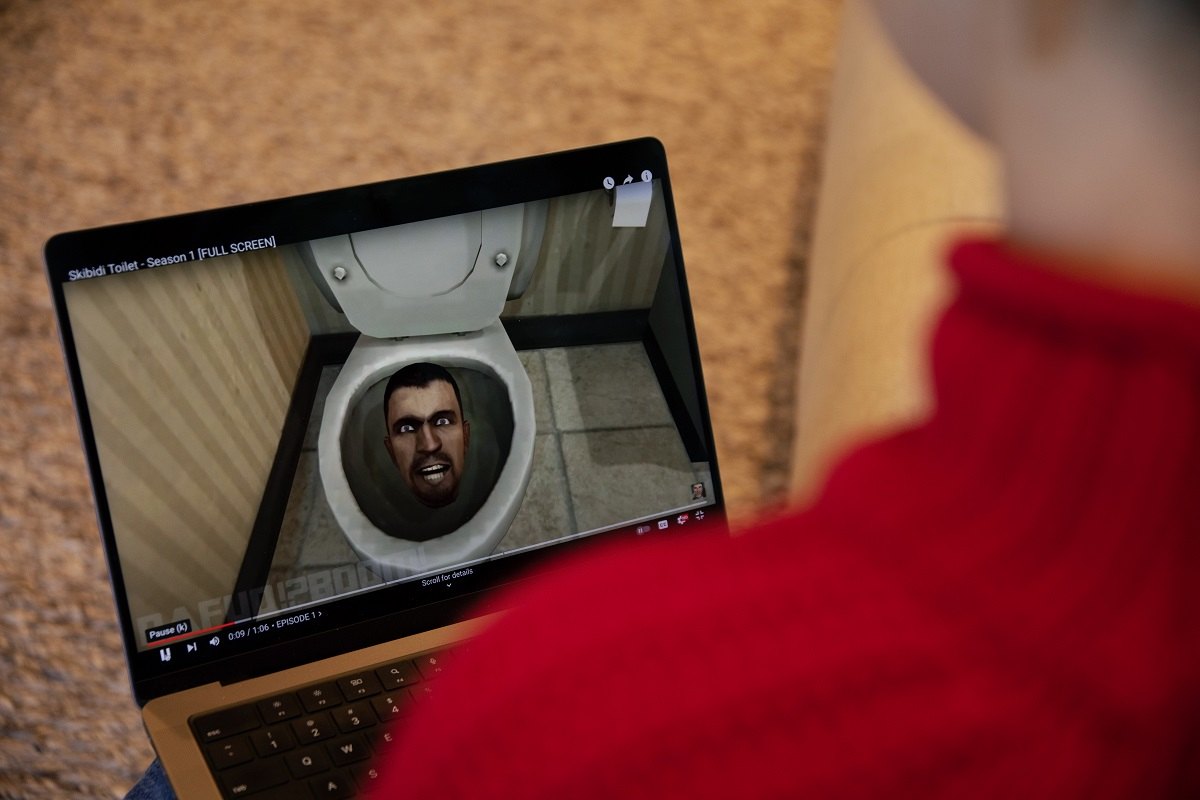
A person watching Skibidi Toilet on a laptop.
12:44 JST, December 11, 2023
The biggest online phenomenon of the year is an animated video series that primarily appeals to children, filled with obscure internet and gaming references that most adults wouldn’t understand, and with a name that all but screams scatological humor.
Its existence has sparked concern among adults, but is in fact a natural outgrowth of a video world created in part by parents who’ve made a habit of handing their iPads to their children to watch harmless entertainment such as “Cocomelon.” The success of the series also shows the first point of tension between Gen Z and Gen Alpha.
Called “Skibidi Toilet,” the YouTube series was created by an animator named Alexey Gerasimov for his YouTube channel DaFuq!?Boom! The series tells the story of Skibidi Toilets (toilets with human heads) engaged in a war with people who have CCTV cameras, speakers and televisions for heads amid a dark and dystopian landscape. They battle each other across an expanding industrial world that includes New York City landmarks, with the Skibidi Toilets acting on behest of their leader, G-Man, to destroy humanity and transform more people into Skibidi Toilets.
“Skibidi” videos have been viewed more than 65 billion times this year on YouTube alone, making it one of the biggest trends on the platform. On TikTok, videos with the hashtag “Skibidi Toilet” have been viewed more than 15.3 million times, and they’ve appeared in countless memes and videos on Instagram. DaFuq!?Boom! also has surpassed 36 million subscribers on YouTube, becoming one of the fastest-growing channels on the platform, at times outpacing MrBeast, YouTube’s biggest star.
Maddy Buxton, culture and trends manager at YouTube, said “Skibidi Toilet” is a phenomenon unlike any other the platform has seen before.
“It’s become one of the year’s biggest cultural moments,” she said. “I’ve never quite seen anything blow up like this. It started as a meme but it’s evolved into this very complex storyline with a lot of hidden meaning that people are very eager to break down and try to understand.”
“Skibidi Toilet” may seem easy to write off as an internet fad, but its ascendance reveals what the future of entertainment might look like across major social platforms. It is the first narrative series to be told entirely through short-form video (60 seconds or less), and it’s the first major mainstream meme that has arisen from Generation Alpha (kids roughly age 10 and younger).
“This is one of the first memes that we’ve seen take off with Gen Alpha and it’s one of the first Gen Alpha trends we’ve seen on YouTube,” Buxton said by phone.
With so much focus on TikTok as a culture driver over the past few years, “Skibidi Toilet” is also a testament to the enduring power of YouTube. In one episode, one of the toilet people destroys YouTube’s headquarters in what the YouTuber Matthew Patrick called “a not-so-subtle metaphor for how the show has broken the website and . . . created a level of virality that has never been seen before.”
While Gen Zers initially appreciated the nostalgic gaming element of the series, many of them now feel uncomfortable and have made reaction videos and memes lamenting its growth.
Sophie Browning, 21, a content creator and meme account administrator, says that’s a natural reaction to Gen Z being supplanted as the driver of online culture. “This is the first time Gen Z feels old or out of touch with meme culture,” she said. “We’ve been told that we run memes and control what’s popular and funny, but now I think Gen Z is reckoning with the new Alphas. It’s unnerving for them to encounter this big meme phenomenon that they don’t feel a part of and didn’t contribute to.”
Gerasimov, a 25-year-old self-taught animator and a member of Gen Z, began creating the series earlier this year. He created the DaFuq!?Boom! video channel in 2016 and for years attracted a modest following by posting humorous animated videos.
He creates his animation using a computer graphics tool called Source Filmmaker that allows users to create animations in the style of an early video game called Garry’s Mod. Garry’s Mod was an online world building sandbox (or space to play around in) similar to “Minecraft.” “Early YouTube was filled with GMod videos, the exact same way “Minecraft” videos dominate the platform today,” Ryan Broderick, a journalist and content creator, noted in his Garbage Day newsletter, adding that Gerasimov’s channel veering deeply into “weird internet aesthetics” played into young people’s nostalgia for the internet of the early 2010s.
Said Buxton: ” ‘Skibidi Toilet’ really plays with the language of the internet in ways Gen Z and Gen Alpha are more used to and have grown up with.”
The word “skibidi” comes from the series’ recurrent theme song, a mashup of the 2007 song “Give It to Me” by Timbaland and a 2022 Turkish song called “Dom Dom” that went viral on TikTok last year. The first few “Skibidi” videos were relatively straightforward toilet humor, but soon evolved into complex narratives.
YouTube says that this rich storytelling has spurred a highly dedicated community online that has created an endless stream of “Skibidi Toilet” fan fiction, art, writing and games inspired by the series.
” ‘Skibidi Toilet’s’ success is a reminder that YouTube is not just about polished productions and celebrity endorsements. It’s a space for creativity, experimentation and the unexpected,” Buxton said.
Ben De Almeida, a 24-year-old YouTuber with nearly 7 million subscribers, said he watched nearly every episode of “Skibidi Toilet” on a live stream a couple of months ago and has begun to understand its appeal. “I’ve never seen episodic type [entertainment] on YouTube Shorts,” he said. “Especially for Gen Alpha kids, I don’t think there was any narrative series they could keep coming back to on Shorts.”
But he says he now sees why it’s appealing, especially to young people.
“It’s not something you have to watch every episode to understand,” he said. “There are common characters and themes, and it just gets bigger and bigger. All you really have to know is it’s the toilet people fighting the camerahead people and then new characters come in.”
The entertainment news website Cartoon Brew reported that “Skibidi Toilet” “may look rough around the edges compared to major studio fare, but there is no question that Gerasimov is a filmmaker who understands pacing, camerawork, sound design, and how to tell a story.”
De Almeida said he has watched as Skibidi memes have spread among elementary school-age children. Said Broderick: “‘Skibidi Toilet’ is one of those things where you might not know what it is, but you know some 5-year-old is watching it and they think it’s the funniest, best thing they’ve ever seen in their life.”
The series is so deeply of the internet that it appeals almost exclusively to those who are young enough to have been fully immersed in online content since their earliest memories. These Gen Alpha kids who make up the majority of the “Skibidi Toilet” audience are often loosely referred to online as “iPad babies” because social media content has been their primary form of entertainment since birth.
“I can’t help but wonder if ‘Skibidi Toilet’ is a consequence of iPad babies growing up watching hours and hours of YouTube Kids, which is known for its nonsensical videos featuring characters from various movies, games and TV shows,” Browning said. “I think being exposed to YouTube Kids has had an effect on kids’ humor.”
Older people without a deep intrinsic knowledge of internet culture are unlikely to understand the appeal of the series, Broderick said. “It’s such a late-stage internet thing because it’s based on previous internet culture artifacts,” he said.
Online culture experts said that you can see the direct influence of TikTok on the series. It’s short form and often uses viral TikTok sounds. “Gen Alpha are spending their development years on TikTok,” Browning said. And the sort of collaborative, iterative, short-form storytelling seen on the app is very tied with “Skibidi Toilet.”
Many of the references in the “Skibidi Toilet” series also come from gaming. The leader of the Skibidi Toilets, G-Man, is actually a character from the “Half-Life” series of first-person shooter video games, and the camera-headed people often engage in “Fortnite” dances.
Despite its young audience, “Skibidi Toilet” appears on YouTube, not YouTube’s app for children’s content, and the company said that theoretically only kids ages 13 and older are supposed to be able to view the content. But parents frequently pass iPads off to young children, who freely view content on YouTube’s primary app. “Skibidi” costumes for elementary school-age children were a hot commodity this past Halloween.
“If YouTube thinks anyone over the age of 13 is watching hours and hours of ‘Skibidi Toilet,’ they’re out of their minds,” Broderick said. “It’s not something anyone with a fully formed brain is enjoying.”
Videos of children begging to watch “Skibidi Toilet” have gone viral on TikTok and Instagram and kids have begun playfully hopping out of objects singing the “Skibidi Toilet” song while pretending to be Skibidi Toilets, baffling parents.
This summer, the slang phrase “Skibidi Toilet syndrome” emerged to speak to the effects that relentless “Skibidi Toilet” viewing has on young children. The TikTok account of one elementary school-age child humorously documents his descent into “Skibidi” madness, with videos of him throwing tantrums when he’s unable to watch the YouTube videos.
The viral craze has led to panic among adults who can’t understand the frenzy their children have developed around the series. Several parenting sites have published articles on “how to protect your kids” from “Skibidi Toilet” syndrome, claiming that the videos are “dangerous.”
But YouTube’s Buxton says the series is all in good fun. “It’s an epic good-versus-bad story told across short-form video,” she explained. There’s no dialogue in the series, which has allowed it to gain international appeal.
Browning also dismissed any worries about its popularity among young children. “I think older generations are threatened by it because it feels so foreign to them,” she said. “It is an admittedly strange visual. I can see how people can be disturbed by it. It’s very surreal and crazy, but I feel like Gen Alpha is used to seeing surreal and crazy things on the internet.”
"News Services" POPULAR ARTICLE
-

American Playwright Jeremy O. Harris Arrested in Japan on Alleged Drug Smuggling
-

Taiwan President Shows Support for Japan in China Dispute with Sushi Lunch
-

Japan’s Nikkei Stock Average as JGB Yields, Yen Rise on Rate-Hike Bets
-

Japan’s Nikkei Stock Average Licks Wounds after Selloff Sparked by BOJ Hike Bets (UPDATE 1)
-

Japanese Bond Yields Zoom, Stocks Slide as Rate Hike Looms
JN ACCESS RANKING
-

Japan’s Hopes for Seafood Exports Shot Down in China Spat
-

Keidanren Chairman Yoshinobu Tsutsui Visits Kashiwazaki-Kariwa Nuclear Power Plant; Inspects New Emergency Safety System
-

Japan to Charge Foreigners More for Residence Permits, Looking to Align with Western Countries
-

Japan Exports Rise in October as Slump in U.S. Sales Eases
-

Govt Aims to Expand NISA Program Lineup, Abolish Age Restriction



























